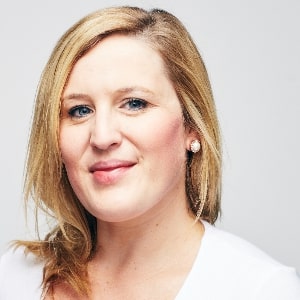I’m a computer engineer transformed into a ⚙️ passionate No Coder ⚙️. Reach out if you want to get introduced or learn more about the No Code world!
It’s not so complicated: Revenue Operations
How can a revenue operations team maximize your bottom line and integrate all teams within a business?
Sarah Harkness is the CEO and co-founder at Cattle Dog Digital and a RevOps expert.
She uses revenue operations and growth hacking strategies to reduce businesses’ revenue leakage and drive costs out.
You learn more about:
- What RevOps is
- Why it is important
- What is the difference between RevOps and Sales Ops
- The key revenue operation metrics and the role of technology
- How to get started
And all these in less than 17 min.
Transcript
Sarah Harkness: So hi. My name is Sarah Harkness. I’m the CEO and Co-founder here at Cattle Dog Digital. We are helping organizations with their growth strategies and fixing any revenue leakage via DevOps. So really excited to have a chat today to talk about how we can really accelerate lead-to-quote to cash through DevOps and how we might be able to work together.
Spyros Tsoukalas: Sarah, welcome to the Growth Mentor Podcast is the first time we record from Sydney. So thanks for taking the time. Let’s cut to the chase, could you share with us something that we don’t know about revenue operations?
Sarah Harkness: Absolutely. RevOps is not just for operations. RevOps is both an operating paradigm, as well as an operations mode. So, I think there are quite a lot of challenges at the moment in distilling what RevOps actually should mean. I actually think DevOps isn’t the best word for it. And a good friend of mine who runs RevGenius actually said, it’s really more of a growth hacking mode. So it’s a growth partner within your organization, aligning all your departments in your divisions, to really remove just that, the divisions within the organization to create flow, we like to call it flow or create harmony, and remove some of the dysfunction that might be blocking some of that revenue cycle and accelerating the output.
Spyros Tsoukalas: That’s pretty new for me. So let’s start with the basics. What are revenue operations like according to your experiences?
Sarah Harkness: Well, it’s really the marriage between all departments going in the same direction towards a revenue goal. It’s not just a revenue goal, it’s also a customer goal. So every organization is in business to make money, whether you’re even in a nonprofit, you still need money in order to meet the cause, that you’re a nonprofit, for having everybody aligned to that mission. And that goal is the first step. The second component of really what it means to have a RevOps operating paradigm is that you then have all of those different departments within the organization, sales, marketing, customer service, product, finance, everyone really working together in harmony in some way, and the systems and tools underpinning those processes to help you reach those revenue goals.
Spyros Tsoukalas: For me, it’s a new term. So, why are revenue operations important nowadays?
Sarah Harkness: Well, it’s corporate Nirvana is what I would say, organisation or Nirvana would be, really, it’s without it, you end up having silos within your organization or you have pockets of each of these elements. So you might have a really fantastic marketing team and a really great sales team. But sales or marketing don’t talk to each other. Or they have different KPIs or marketing doesn’t even have KPIs. They just spent all the money and say, here are all the leads, but the leads aren’t getting converted. So at some point, along this revenue process, you’ve got what we call revenue leakage. And we’re really trying to look at how we can streamline these people processes and the technology to ensure that you minimize that revenue leakage and accelerate the revenue output.
Spyros Tsoukalas: Amazing. So, given that you are active in this industry, what do successful revenue operations look like? How are they executed?
Sarah Harkness: In any number of ways you actually often don’t even realize that there are RevOps in your organization. It’s just you don’t necessarily call it that yet. For example, take a look at a great example Calendly. They’ve got 40 people just in their RevOps division within their organization. Starts with the CRO, and then they actually implemented a team and it’s their sole job to create collaboration across all of these different departments and support the technology stack or the rev tech stack if you will. That’s what I would say the top of the belt Have, most organizations are nowhere near that they’re miles from reaching. You know, as I said, Nirvana, if you will. They’re probably about stage one or two, where maybe sales and marketing do work together. But customer service is being left behind, or their systems and tools are not talking to each other. So, you’ve got a pocket or a silo of data that has to be manually provided or handed over. So you’ve got a distrust. We call that digital dysfunction. And that digital dysfunction is what’s creating revenue leakage in organizations at the moment.
Spyros Tsoukalas: So you have been mentioning the interaction among different themes. Would you elaborate a little bit on like, what themes or what roles have to interact in order for an organization to achieve more successful revenue operations?
Sarah Harkness: Absolutely, I think first and foremost sales and marketing. But we’ve been saying that for years. Now, there’s absolutely more of a push for customer service to get involved. What I’ve really been seeing more of and the trend can continue to never cease to amaze me is that customer service is becoming more like marketing, and sales are becoming more like customer service. Marketing is becoming more like both. So marketing is becoming more and more of that really critical piece of the puzzle to deliver on. We call them PQLs or MQLs. I think you need both, you need a pre-qualified lead and a marketing-qualified lead in your organization, which should then hand over to a sales-qualified lead. And structuring your organization across these different departments to kind of have that seamless, handover is half the battle. But definitely, sales marketing, and customer service, at a minimum, should be collaborating.
Spyros Tsoukalas: Do they have to go one step even, like deeper, for example, conversion rate optimization, this is something that changes the output of our webpage or campaigns. Even the specialists within those teams should be interacting with the structure that you’ve explained, is that right?
Sarah Harkness: 100%, 100%. If you have the funds, and the resource – we call them unicorns – and if you can actually find a RevOps practitioner, then put them in your organization and get them to start bringing these different pieces together. But that’s the beginning of your site, your CRO org, within your organization. And ultimately, that’s what you want, the CRO shouldn’t just be in charge of sales and marketing. They should also have this RevOps org within the organization. It really is a function in the business. It is a relatively new function because it kind of is a bit of everything. But if you can help arm, the people within the RevOps function to collaborate better across the different departments, then you could turn someone that’s in IT, for example, into a RevOps practitioner in your organization.
Spyros Tsoukalas: Very clear. You gave me a pass to ask the following I have been thinking about it like since the very first time I heard about RevOps when we started discussing about this episode. What’s the difference? Like with sales operations? What can confuse people? You mentioned the street departments earlier. So would you elaborate on that?
Sarah Harkness: Well, mops and sops, it’s all RevOps baby. To be honest, it’s just I’m not even gonna say it’s not a wolf in sheep’s clothing. It’s just what we haven’t done a good job of, is distilling down that RevOps is a growth partner within your organization. It is a growth partner, as well as an operational-minded person who has at least some degree, it’s not even just one person, it should really be a team. In an ideal world, the size of your RevOps team is really going to depend on the size of your organization. One of the customers that we worked with their RevOps team was about five people supporting about a billion dollar revenue. So, you know, you can do a lot with a small amount of a team, even one person who becomes a cross-functional RevOps mind within your organization can effectively make a significant change.
Spyros Tsoukalas: Really clear and understood, like I have started admiring these growth partners within post-revenue organizations. So, let’s say that we are a founder or a team within a startup or a company post revenue, of course. And we listened to Sarah talking about revenue operations, and we decide to start an initiative within our company on the topic. What should we be doing? What should be should we be avoiding?
Sarah Harkness: Well, I’ve been doing this for almost a decade. So I definitely have seen a few pitfalls. Let me start with what you should be doing. The very first thing that you can do, and it’s super easy. There are so many resources available out there already that you can find, but if you want to host check yourself, you want to actually look inwards within your own organization and try to identify and create the backlog of dysfunction. I call it the matrix of pain because it really is about a general list of all the issues that you’re having. So you’re sitting, let’s say on the CIO, or even go one level down, and I’m GM of sales, or I’m in marketing. And I’m sitting in the general team meeting, and I’m hearing arguments happening about why these leads aren’t deeply valuable to sales and why they’re not converting. And I’m hearing the back and forth going on. That’s one of the things I would write down, put that on my backlog, and say, well, there’s a reason for this. And that’s because we haven’t clearly defined what that handover process is, or what that definition of a qualified lead is. And we haven’t got a consolidated worldview of that, across my organization, that’s a relatively easy thing to fix. But if your system then doesn’t support that, and you’ve just handed over continuously MQLs that aren’t even reflective of what an MQL definition is, you’re going to be amplifying the dysfunction with technology. Typically, by the time someone’s, you know, looking to turn to RevOps, it’s because the tech has already amplified the dysfunction so loud, that it’s become such an issue, right? Like, once it hits the tech, you know, we’ve got to do something about it.
Spyros Tsoukalas: What are the key metrics that they should be paying attention to? Because obviously, it’s revenue, but what else?
Sarah Harkness: Oh, God, yes. So PQL, like the pre-qualified lead, MQL, to SQL to SAL, then you get into the quote to cash. And this is where there’s a really interesting, you know, additional acceleration that you really got to think about. And this is where there are amazing tools that can help accelerate that within your CRM. So on top of the CRM stack, you should be looking at your CPQ tools that can help to accelerate the contractual process. So as you’re going through the opportunity stages, this whole RevOps process doesn’t end, just as soon as you create an opportunity, once that opportunity is in flight, it is then down to the salesperson and the customer to negotiate their way through that buying cycle. But the system then needs to make that really easy for customers to buy and make it really fun or engaging or seamless, right? Whatever it is that metric or experience that you’re trying to curate as an organization. At that point, you should be so solid and so watertight in that experience, that once you hand that sale over as soon as that’s close, that contract is one that the invoice gets sent out, and there is no delay in the invoice being paid because that whole end process of the funnel is also sought as well. I think we don’t want to forget any of this discussion that a big part of RevOps is finance, and at the end of the funnel, I think it’s the forgotten dark arts. And actually, there’s a huge opportunity for organizations to actually capitalize on some small tweaks that can help really make that quote to invoice payment process better. So whether you start at the end of the funnel or the front of the funnel, you start to see what I mean, when we talk about revenue leakage, right? There are so many points of the funnel where things could fall through the cracks.
Spyros Tsoukalas: This was another great pass from you to push me to ask about what’s the role of technology in all this because you mentioned here and there some keywords that I think are highly related to technology. So any ideas about this topic?
Sarah Harkness: Look, you know in our organization we partner with Pedigree rev tech, the tools that we believe over the last 20 years of working in the industry to be the best tools used to really accelerate your revenue for a particular size organization. I certainly won’t mention all the names on this podcast. But ultimately, what you are able to do with the technology choices you have, you shouldn’t be looking to the tech to solve the problem. The tech will not solve your problem, the tech will amplify your problem. And the tech will annoy you and make you cranky. So what we want to do is really get the most out of our investment in the tech. And we don’t just put in solutions for the sake of solutions. We put in tech based on understanding the implication of why we’re putting that in in the first place and how that’s going to affect the rest of the funnel process. If we do not do that, then at some point we are going to experience some frustration with the tech because it’s not going to be meeting our objective, if it’s not seamlessly integrated throughout the whole process.
Spyros Tsoukalas: What if we define processes as per our priorities, and then use tools and technology to help us execute or implement those steps?
Sarah Harkness: Absolutely. That’s exactly what we need to do. And the more we can do that, and maintain that and hold ourselves accountable to that, the better. Right? So we want to maintain and hold those workflows in and update those. And again, this is the function of having a revenue operations team that can continuously go back and look at those workflows end to end and keep them up to date. So that even from an onboarding perspective, you get faster onboarding in sales, if sales can follow the funnel on paper.
Spyros Tsoukalas: I am a big fan of tools. So now I feel a little more a little better. Sarah, it was a pleasure having you this morning on the GrowthMentor Podcast and I hope that you enjoyed it as much as I did, and people will learn as many new things as you shared with me.
Sarah Harkness: No worries. Thanks for having me.
In this episode


CRO and revenue coach for organisations looking to grow their revenue and keep it in flow. A cofounder in Cattle Dog Digital I lead lead marketing, sales, customer service, finance and operations experts successfully implement, improve and iterate their company’s RevOps.
Join the community
Enjoy the peace of mind that advice is always only one Zoom call away.

